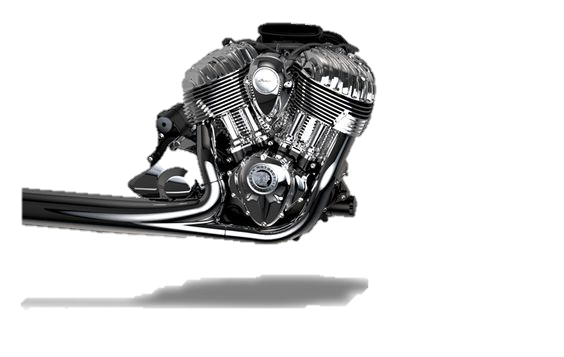

HOME
The Indian Motorcycle Company that was started in 1999 in Gilroy California used the very reliable engine manufactured by S&S Performance from 1999 to 2004. This engine platform was used in all product lines with the exception of the 2002 to 2004 Indian Chief. In 2002, Indian of Gilroy began using their own engine design called the Power plus 100. There was also an engine produced by S&S Performance in 2003 which was a 92 CID that was visually similar to the Power plus 100 in some way. Round cylinders and heads etc. This particular engine came on board in 2003 just before Indian of Gilroy closed. The production numbers were very low and not many were produced. The S&S Super Stock 88 engine is a great power plant. It was manufactured at S&S Performance as well as the Gilroy Indian factory. It was fitted with a S&S Super E Carburetor, Thunder Heart electronic ignition system and came with an S&S 520 camshaft. The compression ratio varied from 9.4:1 to 10.5:1. You could order the engine in black with polished fins and chrome rocker boxes or "Raw" finish with polished fins and chrome rocker boxes. A very well know engine for Indian of Gilroy to use during their development period of the Power plus 100. The S&S engine was basically and engine based off of the HD V-Twin (45 degree V). The S&S is a 1438cc with a bore of 3-5/8 bore x 4.250" stroke. The compression ratio was 9.25:1, The combustion chamber volume was 86cc. Flywheel diameter is 8.50", connecting rod length is 7.440", wrist pin diameter .792". The intake valve head diameter was 2.00" and the exhaust is 1.605". Power output was approximately 75 HP and 80 ft.lbs. of torque. A proven engine from S&S.

Indian introduced their own engine starting in 2002 that was slated to replace the S&S Super Stock 88" for the model year in 2002 Indian Chief.. The engine was configured in a V-45. Many of the internal parts were shared with the HD V-45 engine such as camshafts, rocker arms, flywheel (with the exception of the pinion shaft length). The engine case had three variations of manufacturers. Falco, Mansfield and Ransom through is short production period. Falco and Mansfield produced the bulk of the engine cases, cylinders and cylinder heads. Indian was using their own crankshaft design and components. Due to unfavorable tolerances during the manufacturing process and assembly procedures, the flywheels either had to be re-manufactured or replaced. The engine used a Mikuni HSR 42 Carburetor, Thunder Heart dual fire ignition system, with an optional single fire ignition system available from Thunder Heart. The carburetor was located on the left side of the engine and the ignition system located on the right side as with most V-Twin engine. The flywheel is a 8.5" diameter with a 4.250" stroke and a cylinder bore of 3.875". The camshaft was made by Andrews with a lift of .560". The stock engine produced 68 HP and 72ft.lbs of torque. Compression ratio varied from 9.0:1 to 10.5:1 depending on the cylinder heads. The 2002 cylinder heads had a combustion chamber ranging from 83cc to 88cc in size. By just replacing the stock exhaust and air filter system, the power output would increase to over 80 HP and close to 92 ft.lbs. of torque. The engine referred to as the "Bottle Cap" was used from model years 2002 to 2004. JAM, Ltd. offers various size and configurations of the Powerplus 100.
S&S Super Stock 88 CID

S&S Super Stock short block

Indian Power plus 100

Indian Power plus 100 short block

Indian Thunder Stroke 111
Indian introduced the Thunder Stroke 111 in 2013. The all new power plant was to be installed into the the Indian Chief. I remember when the new Indian Motorcycle Company asked the customer base (Gilroy Indian Owners) what the engine should look like and this is the engine that same from the owner's of Indian Motorcycles. The engine has a taste of the old with a lot of technology added. With the influences and experience of Polaris Industries, they are the best company to inherit the Indian Brand and has carried the torch to success. A combined engine and transmission was a break away from the traditional American V Twin. The previous Indian motorcycle (Gilroy and Kings Mountain) engine and transmission were separated and connected by a primary drive unit. See specification here on the Thunder Stroke 111.
